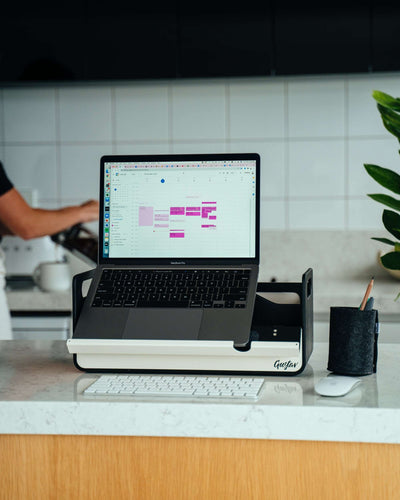Hoe u de juiste desk-sharing verhouding voor uw kantoor berekent

Wat is een bureau-deelverhouding?
De bureau-deelverhouding (soms bureau-werknemer verhouding genoemd) beschrijft hoeveel werkplekken beschikbaar zijn in vergelijking met het totale aantal werknemers.
Er zijn twee gebruikelijke manieren om het uit te drukken:
-
Als een percentage:
Een bureau-deelverhouding van 80 % betekent dat er voor elke 100 werknemers 80 bureaus beschikbaar zijn. -
Als een numerieke verhouding:
Een verhouding van 1.2 betekent dat er 120 werknemers zijn voor 100 bureaus.
Beide beschrijven dezelfde relatie — de eerste richt zich op beschikbare bureaus, de tweede op totaal personeel.
Tabel voor Desk-Sharing Conversie
| Als een percentage | Als een numerieke waarde |
|---|---|
|
100% → 1.00 desk/employee |
1.00 desk / 1.00 employees |
|
90% → 0.90 desks/employPresence % (Desks per Employee)ee |
1.00 desk / 1.11 employees |
|
80% → 0.80 desks/employee |
1.00 desk / 1.25 employees |
|
70% → 0.70 desks/employee |
1.00 desk / 1.43 employees |
|
60% → 0.60 desks/employee |
1.00 desk / 1.67 employees |
|
50% → 0.50 desks/employee |
1.00 desk / 2.00 employees |
|
40% → 0.40 desks/employee |
1.00 desk / 2.50 employees |
Het begrijpen van de desk-sharing ratio van uw bedrijf is een cruciale eerste stap in elk hybride werkplek- of kantoorruimteplanningsproject.
Waarom Desk Sharing Belangrijk is voor Hybride Werkplekken
Bedrijven passen desk sharing toe om flexibelere, efficiëntere en duurzamere werkplekken te creëren.
In de meeste gevallen zijn er twee hoofddoelen:
-
Flexibiliteit en aanpassingsvermogen
Desk sharing stelt organisaties in staat om teamgroottes, projectgroepen en vloerindelingen eenvoudig aan te passen — zonder constante herinrichting. -
Ruimte- en kostenefficiëntie
Door het aantal bureaus af te stemmen op het daadwerkelijke gebruik, kunnen bedrijven ongebruikte ruimte verminderen en hun real-estate footprint optimaliseren.
Wanneer doordacht geïmplementeerd, ondersteunt desk sharing de autonomie van medewerkers en verlaagt het aanzienlijk de vastgoed- en energiekosten.
Desk-Sharing Verhoudingen – Een Bewegend Doel
De aard van modern werk is constante verandering — en daarmee komt de behoefte aan flexibiliteit. Dit is een van de belangrijkste redenen waarom desk sharing zo populair is geworden. Maar hetzelfde principe geldt voor de desk-sharing verhoudingen zelf: ze veranderen in de loop van de tijd naarmate het aantal medewerkers, teams en werkpatronen evolueren.
Om de verhouding goed te krijgen, moeten organisaties continu de bezettingsniveaus, het gedrag van medewerkers en de tevredenheid monitoren. Deze inzichten maken het makkelijker om flexibel op- of af te schalen wanneer nodig, zodat de werkruimte efficiënt, comfortabel en afgestemd blijft op hoe mensen daadwerkelijk werken.
Hoe bereken je je desk-sharing verhouding
Er zijn twee hoofdbenaderingen om de juiste bureau-tot-medewerker verhouding te berekenen:
een best-practice schatting en een data-gedreven analyse.
1. Gebruik Best-Practice Cijfers (Schatting)
Als je aan het begin staat van je desk-sharing traject en nog geen gebruiksdata hebt, gebruik dan deze industry benchmarks als richtlijn:
| Type organisatie | Typische verhouding | Beschrijving |
|---|---|---|
| Traditioneel kantoorwerk | 80 - 85% (0.8 bureaus per medewerker) | Conservatieve basislijn gebruikt in verschillende sectoren. |
| Hybride / flexibel werken | 70 – 75 % | Geschikt wanneer werknemers één of twee dagen per week thuiswerken. |
| Agile, mobiel of verkoopgericht | 50 – 65 % | Alleen haalbaar met sterke reserveringssystemen en duidelijke beleidsregels. |
2. Gebruik echte gegevens (beste aanpak)
Voor een nauwkeurigere berekening analyseer hoe mensen uw kantoor daadwerkelijk gebruiken.
Dit kan worden gedaan via:
-
Toegangskaart- of badgegegevens: meten dagelijkse aanwezigheid.
-
Bureau-reserveringssoftware: volgt de bezetting van bureaus in realtime.
-
Handmatige benuttingsstudies: uurtellingen van bezette bureaus over een of twee weken.
-
Medewerker enquêtes: onthullen thuiswerkpatronen en voorkeuren.
Hoe meer gegevens u verzamelt, hoe nauwkeuriger u uw bureaudeelratio kunt instellen.
Als bijvoorbeeld uit analyse blijkt dat de wekelijkse piekbezetting van bureaus 65 % is, kunt u veilig plannen met een bureaudeelratio van 75-80 %, met als doel een piekbezetting van 85-90% zodat er ruimte is voor piekdagen. (10-15% ruimtecapaciteit)
Wat een goede bureaudeelratio maakt
Een succesvol model voor bureaudeelname bevat altijd een buffer voor flexibiliteit — doorgaans 10 – 15 % reservecapaciteit, met als doel een gemiddelde piekbezetting van 85-90%
Dit zorgt ervoor dat werknemers nog steeds gemakkelijk een bureau kunnen vinden, zelfs op drukke dagen.
Als de gemiddelde piekbezetting van bureaus regelmatig meer dan 85 % bedraagt, kan de werkplek overvol en stressvol aanvoelen. Het doel is om het systeem moeiteloos en intuïtief te maken, niet beperkend.
Hoe u bureaudeelname in de loop van de tijd optimaliseert
Bureaudeelname is geen "set-and-forget"-model. Zodra het is ingesteld, moet u regelmatig uw ratio monitoren, beoordelen en aanpassen:
-
Volg het gebruik continu via reserverings- of sensorsystemen.
-
Verzamel feedback via kwartaal-enquêtes onder personeel.
-
Stem beleid af met leiderschap, HR en facilitaire teams.
-
Pas ratio-doelstellingen aan naarmate thuiswerkgewoonten evolueren.
Na verloop van tijd kun je de ratio meestal verder verlagen — bijvoorbeeld van 80 % naar 70 % — zodra betrouwbare data de verandering ondersteunt.
Veelvoorkomende succesfactoren voor desk sharing
Hoewel de ratio belangrijk is, hangt succes ook af van andere factoren op de werkplek:
-
Ondersteunend leiderschap en duidelijke communicatie.
-
Goed ontworpen ruimtes die passen bij verschillende werkmodi.
-
Betrouwbare IT-tools en bureau-reserveringssystemen.
-
Transparante beleidsregels en eerlijke regels voor bureau-toewijzing.
Samen creëren deze een positieve werknemerservaring en behouden ze het vertrouwen in het desk-sharing model.
Belangrijkste conclusies
-
Begin met een desk-sharing ratio van ongeveer 80 % als er geen data beschikbaar is.
-
Gebruik real-world utilisation data om dit te verfijnen en mogelijk te verlagen.
-
Behoud 10-15 % reservecapaciteit (streef naar een gemiddelde piekcapaciteit van 85-90%) ten opzichte van de waargenomen piekbezetting om comfort en bruikbaarheid te garanderen.
-
Combineer je ratio-planning met slimme change management en doordacht werkplekontwerp.
Het uiteindelijke doel is niet alleen ruimte besparen — het is een werkplek ontwerpen die moeiteloos en ergonomisch werkt voor iedereen.
Volgende stap: Tools ter ondersteuning van desk sharing
Ontdek Gustav’s desk-sharing tools — mobiele bureau-caddies, laptopstandaards en accessoires die flexibel werken naadloos, georganiseerd en ergonomisch maken.












